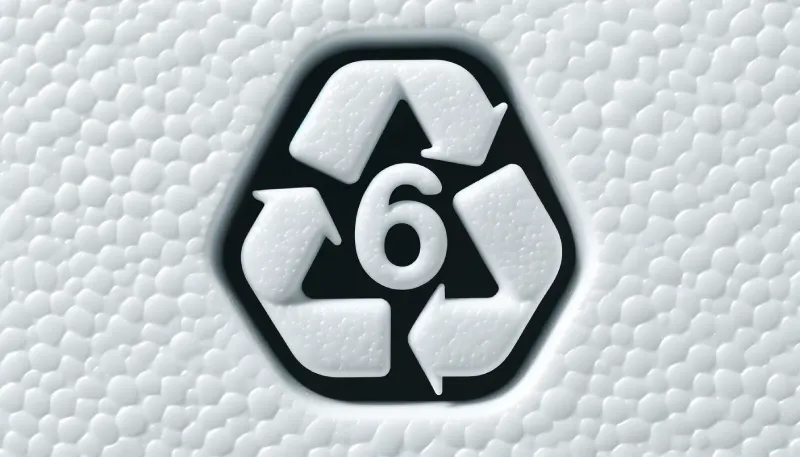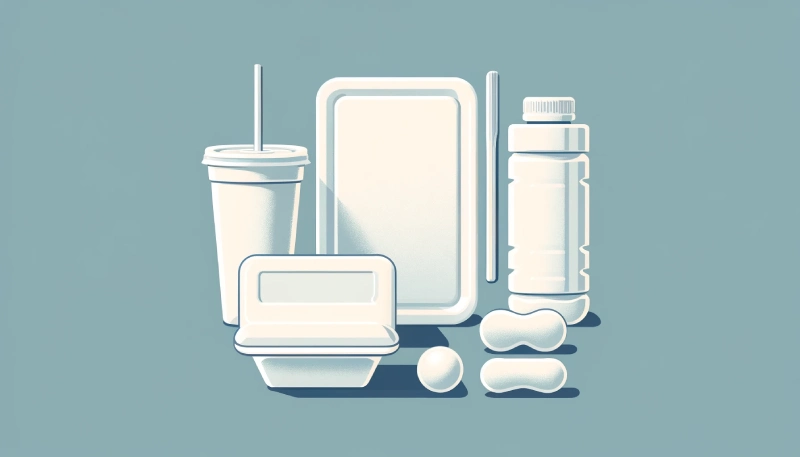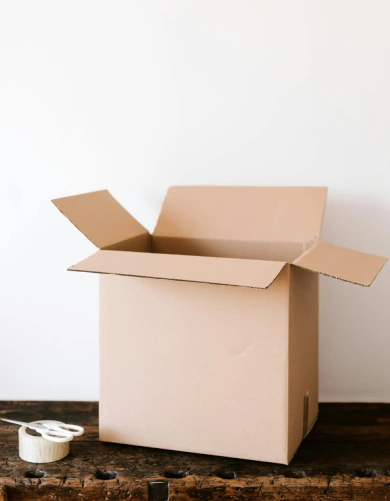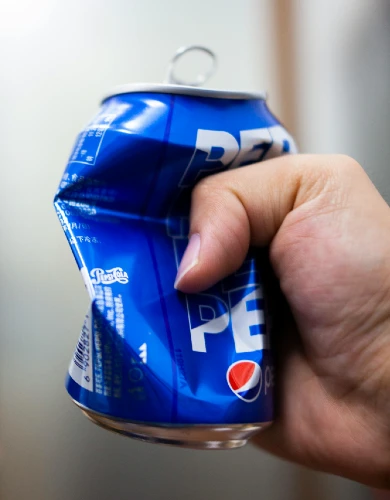Polystyrene recycling in the UK
Polystyrene is everywhere: single-use cutlery, CD cases, insulation inside your walls—you name it.
Yet, only 1–2% of polystyrene waste is recycled in the UK, with the vast majority ending up in landfills or incinerators.
In this guide, we’ll explain the current state of polystyrene recycling in the UK, covering:
- What is polystyrene?
- Common polystyrene items
- The problems of recycling polystyrene
- Options for polystyrene recycling in the UK
- Bans on single-use polystyrene items
- The environmental impacts of polystyrene waste
What is polystyrene?

Polystyrene (PS) is one of the most common types of plastic derived from petroleum. It is non-biodegradable (it takes hundreds of years to break down naturally) and typically very cheap to produce anywhere in the world. While it is a poor barrier to air and water vapour, it is popular because it is:
- Versatile: It can be shaped into virtually any shape and material, including solids, foams and films.
- Insulating: In its foamy state (created by expanding polystyrene beads with gas), it is an effective insulator, perfect for hot drinks and building insulation.
- Lightweight: Its lightweightedness, even in solid form, makes it perfect for packaging and disposable items.
- Cheap: The petroleum necessary to manufacture polystyrene and the simplicity of the process make it a profitable business.
Polystyrene is classified as number 6 in the Resin Identification Code (RIC), which will appear on products. It was discovered in Germany as early as the 1830s, synthesised initially from the sweetgum tree.
The types of polystyrene
Pure Polystyrene can be shaped into multiple types through different processes, each with distinct properties and applications:
| Acronym (Typical state) | Name | Description | Typical products |
|---|---|---|---|
| GPPS (Solid) | General-Purpose Polystyrene | Transparent, rigid, and brittle. Commonly used in products that require clarity and stiffness. | Disposable cutlery, CD cases, laboratory ware |
| HIPS (Solid) | High Impact Polystyrene | Modified with rubber additives to improve impact resistance. Less brittle than GPPS. Used in durable applications. | Appliance housings, toys, packaging |
| EPS (Foam) | Expanded Polystyrene | Lightweight, foam-like material made by expanding polystyrene beads. Structure is 95% air so is an excellent for insulation, cushioning , floation and heat-resistance. | Insulation, packaging, disposable food containers, life vests, rafts |
| XPS (Foam) | Extruded Polystyrene | Dense, rigid foam produced by extruding polystyrene. Smooth surface, used primarily for insulation in construction. | Insulation in walls, roofs, foundations |
| SPS (Solid) | Syndiotactic Polystyrene | Crystalline structure that provides high heat resistance and strength. Used in applications requiring higher temperature resistance. | Microwave cookware, automotive parts |
💡Styrofoam is a common brand name for Extruded Polystyrene (XPS).
Common polystyrene items

Here is a table summarising the main types of polystyrene items that eventually end up as waste, especially those single-use items with high turnover used the food and packaging:
| Product Category | Typical Polystyrene Products | Lifecycle |
|---|---|---|
| Packaging | Food containers, egg cartons, meat trays, yogurt pots | Weeks to months |
| Disposable Tableware | Cups, plates, cutlery, clamshell containers | Hours to days |
| Insulation | Expanded polystyrene (EPS) boards for building insulation | Decades |
| Protective Packaging | Foam peanuts, protective blocks for electronics | Weeks to months |
| Medical Supplies | Petri dishes, test tubes, disposable medical equipment | Days to weeks |
| Consumer Goods | CD cases, plastic models, coat hangers | Years |
💡 Durability: Polystyrene’s longevity is a negative trait once items are discarded, as any litter will persist for hundreds of years. However, when used as insulation in construction, it can last over 50 winters, helping buildings save energy and avoid carbon emissions.
The problems of recycling polystyrene
Only 1-2% of polystyrene waste generated in the UK is recycled. Unfortunately, many properties that make polystyrene useful backfire when it comes to its ease of recycling, making it troublesome and expensive to recycle. Let’s pick them up one by one:
Lightness: Polystyrene in foam form (e.g., EPS and XPS) is light and typically has a large surface area, making it an easy target for wind gusts. Unfortunately, inappropriately stored or transported EPS can easily blow away in the wind and become litter. This lightness also makes it bulky (EPS is 95% air!), which means EPS needs to be compacted before being transported.
Contamination: Polystyrene used in food packaging is typically contaminated with mixed paper, food scraps and other plastics (e.g. plastic straws). This requires prior cleaning and separation, meaning local recycling plants usually lack the resources to handle it. In contrast, plastics like 1 (drinks bottles), 2 (detergent) and 4 (plastic bags) tend to come much cleaner and at a much more constant rate, making them much cheaper to recycle.
Safety: Polystyrene contains styrene, a suspected carcinogen, raising concerns about the safety of recycling workers and the potential release of toxic substances during the recycling process. However, the same can be said about polystyrene being released into the environment as litter or incinerated, sending carcinogenic gasses into the atmosphere.
Degradation: Unlike commercial glass recycling, the quality of polystyrene cannot be maintained after recycling, limiting the number of times it can be reused into a helpful resource.
💡 Not the only one: Other difficult items to recycle include composite plastics, electronic waste, hazardous waste, ink cartridges, and aerosol cans, just to name a few.
Options for polystyrene recycling in the UK
According to data from RECOUP, a leading authority on plastics recycling in the UK, the recycling rate for polystyrene is estimated to be around 1-2% of the total waste generated. In other words, polystyrene recycling is almost non-existent despite being technically recyclable.
This is because polystyrene recycling is more challenging than other types of plastic, such as HDPE and PET, which exist in larger quantities and do not present the same issues. Polystyrene recycling is less cost-effective than popular types of commercial recycling like glass or commercial cardboard recycling.
💡No infrastructure: The UK has no large-scale polystyrene recycling facilities so waste exports are common. Only a handful of small companies recycle polystyrene in the UK, particularly EPS foam, which can be more convenient to process.
As a result, most local commercial waste disposal providers do not support polystyrene recycling, meaning that most businesses dispose of polystyrene waste in their general commercial waste bin.
💡 Pilot plant: In 2022, a pilot plant for advanced polystyrene recycling was planned in Swindon, UK, in partnership with Ineos and Recycling Technologies (Source: MRW).
Despite this lack of large-scale infrastructure, there are notable examples of small businesses that are taking the bull by the horns and making polystyrene recycling a reality:
EPS Recycling
Expanded Polystyrene (EPS) is a granular, lightweight, white-coloured material used to protect and fix large electronics like TVs within their packaging. While it is common, EPS waste is one of the most recycled plastics in the UK because it is typically dry, non-contaminated, and concentrated across specific businesses such as electronics shops.
Some EPS producers, such as Molygran near Manchester, also run their own recycling programs. In their case, they receive, compact and pelletise it for later recycling at another facility in a process that goes as follows:
- Reception: Molygran receives clean and dry EPS from companies and individuals for free at their facility.
- Compaction & Grinding: EPS of all sizes and conditions are ground and compactor together to form EPS Briquettes, which reduce the size of EPS by 95%. These are palletised for transport.
- Melting & Processing: The briquettes are transported to a generalised plastics recycling facility, where they are melted and moulded into pellets sold as 100% recycled plastic and made into new products.
Products from recycled EPS/XPS
Here are some of the creative ways in which recycled EPS (and also XPS) can be used in a circular economy:
- Construction: EPS briquettes can be directly reused as building insulation or lightweight fill material in infrastructure projects, and XPS briquettes can be used as moisture-resistant underlayments in flooring.
- Packaging: Given their insulating properties, EPS briquettes can be ground into beads and used as protective packaging for delicate items, providing shock and heat protection.
- Upcycled ‘Wood’: Recycled EPS is being used to make a polystyrene ‘wood’-looking product that is becoming popular as a hardwood replacement in park benches and fences because of its low cost and durability.
Polystyrene waste avoidance and minimisation
We can’t discuss recycling without mentioning its place in the waste hierarchy. Remember that all waste management strategies should seek to avoid the waste first, then minimise/reduce it, and only if this is not possible, recycle it.
In this respect, the latest legal waste act in the UK (EPA 2021) introduced a concept called Extended Producer Responsibility (EPR), which makes businesses that manufacture, import, or sell products responsible for the end-of-life environmental impact of their products, many of which contain polystyrene. While this has not been extensively applied, it forges a legal path to avoid polystyrene waste.
Other waste minimisation strategies include businesses purposefully avoiding polystyrene products, reusing them where possible, and speaking with the local council and commercial waste collection providers to see if any polystyrene recycling infrastructure is nearby.
Bans on single-use polystyrene items
Each UK home nation has already implemented bans on single-use plastic (including many polystyrene items) using their devolved regulatory powers. Note that these are bans on the sale of these items:
| Country | Date of Ban | Details |
|---|---|---|
| England and Wales | October 2023 | Ban on single-use plastic plates, bowls, trays, cutlery, balloon sticks, and certain types of polystyrene food and drinks containers, including cups. Exemptions for trays and bowls used as packaging in pre-packaged food items. |
| Scotland | June 2022 | Ban on manufacturing and supply of single-use plastic cutlery, plates, expanded polystyrene beverage cups and containers, beverage stirrers, and supply only of plastic straws and balloon sticks. No exemptions for pre-packed items. |
| Northern Ireland | July 2021 (EU Directive) | Ban on certain single-use plastics, including plastic cutlery, plates, and polystyrene food containers, as per the EU Single-use Plastics Directive. No exemptions for pre-packed items. |
The environmental impacts of polystyrene waste
The popularity of polystyrene combined with its troublesome recycling translates to large-scale environmental impacts that were largely ignored by the mainstream until recently. This includes its infamous role in floating plastic islands, microplastics in food and water, the deaths of marine and land animals, and its role in climate change.
Polystyrene litter
When polystyrene becomes litter, it stays as such for hundreds of years, even when constantly exposed to the elements. Solar radiation and acids in the environment cause polystyrene to degrade gradually, leaching harmful chemicals into the natural or built environment.
As polystyrene litter thins out, it starts breaking apart into smaller pieces that can easily be transported in waterways and into the Ocean. These are often ingested by both land and marine fauna, leading to injury, suffocation, or starvation.
Eventually, these small and persistent pieces break down to the micro-level (only discernable in microscopes) and accumulate in soils and water. For example, a study found an average of 84,030 particles of microplastics per square meter in the river Mersey near Liverpool, many of them from polystyrene. The same occurs with dust, with UK homes exhibiting, on average, 1,257 microplastic fibres per square meter.
Atmospheric pollution and global warming
Polystyrene is a petroleum derivative, a non-renewable resource with a significant environmental and carbon footprint. While not a significant source of demand, making polystyrene contributes to the continued use of fossil fuels, the prime cause of climate change.
Additionally, incinerating polystyrene (a large proportion is burnt because so little of it is recycled) releases toxic gases such as styrene and benzene into the atmosphere, contributing to air pollution and posing health risks to humans.

